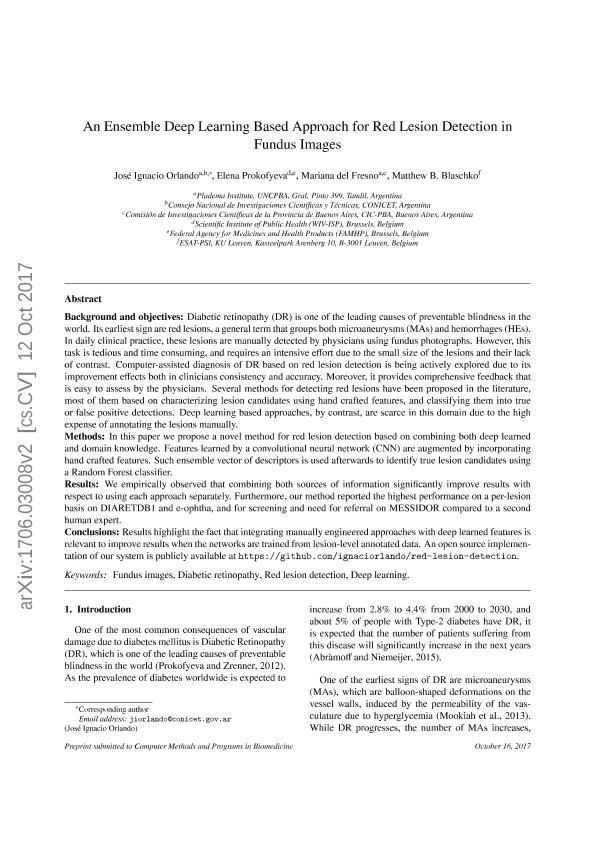Mostrar el registro sencillo del ítem
dc.contributor.author
Orlando, José Ignacio

dc.contributor.author
Prokofyeva, Elena
dc.contributor.author
del Fresno, Mirta Mariana

dc.contributor.author
Blaschko, Matthew Brian

dc.date.available
2020-01-23T21:00:36Z
dc.date.issued
2018-01
dc.identifier.citation
Orlando, José Ignacio; Prokofyeva, Elena; del Fresno, Mirta Mariana; Blaschko, Matthew Brian; An ensemble deep learning based approach for red lesion detection in fundus images; Elsevier Ireland; Computer Methods And Programs In Biomedicine; 153; 1-2018; 115-127
dc.identifier.issn
0169-2607
dc.identifier.uri
http://hdl.handle.net/11336/95719
dc.description.abstract
Background and objectives: Diabetic retinopathy (DR) is one of the leading causes of preventable blindness in the world. Its earliest sign are red lesions, a general term that groups both microaneurysms (MAs) and hemorrhages (HEs). In daily clinical practice, these lesions are manually detected by physicians using fundus photographs. However, this task is tedious and time consuming, and requires an intensive effort due to the small size of the lesions and their lack of contrast. Computer-assisted diagnosis of DR based on red lesion detection is being actively explored due to its improvement effects both in clinicians consistency and accuracy. Moreover, it provides comprehensive feedback that is easy to assess by the physicians. Several methods for detecting red lesions have been proposed in the literature, most of them based on characterizing lesion candidates using hand crafted features, and classifying them into true or false positive detections. Deep learning based approaches, by contrast, are scarce in this domain due to the high expense of annotating the lesions manually. Methods: In this paper we propose a novel method for red lesion detection based on combining both deep learned and domain knowledge. Features learned by a convolutional neural network (CNN) are augmented by incorporating hand crafted features. Such ensemble vector of descriptors is used afterwards to identify true lesion candidates using a Random Forest classifier. Results: We empirically observed that combining both sources of information significantly improve results with respect to using each approach separately. Furthermore, our method reported the highest performance on a per-lesion basis on DIARETDB1 and e-ophtha, and for screening and need for referral on MESSIDOR compared to a second human expert. Conclusions: Results highlight the fact that integrating manually engineered approaches with deep learned features is relevant to improve results when the networks are trained from lesion-level annotated data. An open source implementation of our system is publicly available at https://github.com/ignaciorlando/red-lesion-detection.
dc.format
application/pdf
dc.language.iso
eng
dc.publisher
Elsevier Ireland

dc.rights
info:eu-repo/semantics/openAccess
dc.rights.uri
https://creativecommons.org/licenses/by-nc-sa/2.5/ar/
dc.subject
DEEP LEARNING
dc.subject
DIABETIC RETINOPATHY
dc.subject
FUNDUS IMAGES
dc.subject
RED LESION DETECTION
dc.subject.classification
Ciencias de la Computación

dc.subject.classification
Ciencias de la Computación e Información

dc.subject.classification
CIENCIAS NATURALES Y EXACTAS

dc.title
An ensemble deep learning based approach for red lesion detection in fundus images
dc.type
info:eu-repo/semantics/article
dc.type
info:ar-repo/semantics/artículo
dc.type
info:eu-repo/semantics/publishedVersion
dc.date.updated
2019-10-22T17:47:33Z
dc.journal.volume
153
dc.journal.pagination
115-127
dc.journal.pais
Irlanda

dc.journal.ciudad
Amsterdam
dc.description.fil
Fil: Orlando, José Ignacio. Universidad Nacional del Centro de la Provincia de Buenos Aires. Facultad de Ciencias Exactas. Grupo de Plasmas Densos Magnetizados. Provincia de Buenos Aires. Gobernación. Comision de Investigaciones Científicas. Grupo de Plasmas Densos Magnetizados; Argentina
dc.description.fil
Fil: Prokofyeva, Elena. Scientific Institute of Public Health; Bélgica
dc.description.fil
Fil: del Fresno, Mirta Mariana. Universidad Nacional del Centro de la Provincia de Buenos Aires. Facultad de Ciencias Exactas. Grupo de Plasmas Densos Magnetizados. Provincia de Buenos Aires. Gobernación. Comision de Investigaciones Científicas. Grupo de Plasmas Densos Magnetizados; Argentina
dc.description.fil
Fil: Blaschko, Matthew Brian. ESAT Speech Group; Bélgica
dc.journal.title
Computer Methods And Programs In Biomedicine

dc.relation.alternativeid
info:eu-repo/semantics/altIdentifier/url/https://www.sciencedirect.com/science/article/pii/S0169260717307897
dc.relation.alternativeid
info:eu-repo/semantics/altIdentifier/doi/https://doi.org/10.1016/j.cmpb.2017.10.017
Archivos asociados
